|
In Bulletin 8
I described how we proposed to overhaul the radiator and in
the process return it to original 1946 / 1947 condition with
vertical slatted grille, correct aluminium skirt (replacing
the steel section), but retaining the sunrays type top tank
incorporating hinged filler cap. The spare Glasgow
Corporation radiator, which we had obtained, was of the
earlier type with a top tank incorporating a brass badge
retained by 4 screws and a screw on type filler cap.
The dismantling of 1877's radiator revealed that it was in
very poor condition. The flange round the base of the top
tank was corroded to the point where it was difficult to see
how it could have been watertight. Indeed we concluded that
the light brown rust colour on the tubes was more likely to
have been evidence of leaking coolant rather than corrosion
of the tubes themselves. Also the general condition of the
core was poor and would require a number of replacement
tubes with new rubber seals top and bottom.
On the other hand, when we dismantled the Glasgow
Corporation radiator it was found to be in excellent
condition throughout with a core made up of smaller diameter
tubes with soldered joints top and bottom. If we could use
this radiator as the basis of our rebuild it would save a
lot of time and effort.
As I said in Bulletin 8 all pre-war CX buses and the
earliest post-war CX buses had a top tank with the
rectangular badge and a screw on filler cap. This is the
type shown on the Homepage. If we could find out where the
changeover occurred we might be able to prove that 1877 was
delivered with this type of radiator.
It was time to pull out all the all the Spares Lists and
Instruction Books. An examination of the 1947 CX19 Spares
List revealed the following on page 20 of Section 1:
Radiator with Screwed Filler Cap (to chassis no. 60025H)
part no AS/2J11109.
Radiator with Hinged Filler Cap (from chassis no. 60025H)
part no AS/K11109.
The chassis number of our CX19 is 60023C, twenty-five
chasses before the changeover. So we had landed lucky! Our
CX19 was one of the early ones that came with the pre-war
type radiator. This interesting discovery meant that we
could use the Glasgow radiator which was indeed the type it
was delivered with. But why then did all the pictures of the
Sydney CX19s taken in the 1960s show the later type
radiator? I consulted Dave Wilson of the Sydney Bus Museum
and he came up with some very early pictures of Sydney CX19s
up to chassis number 60025H and they all sported rectangular
badge radiators with screw on filler caps. The final piece
in the jigsaw puzzle had been filled and this meant that we
were entirely justified in using the pre-war type radiator
in this restoration.
Dave reckons that the decision was taken to change the top
tanks at overhaul and standardise on the hinged cap type
radiators which would make it easier for the crews and
maintenance staff to keep the coolant topped up. A sensible
decision in a hot climate.
Indeed a footnote in the 1947 Parts Book tells us, The
latest radiator with Hinged Type Filler Cap will be supplied
for Spares and is interchangeable with the earlier type with
Screwed Filler Cap. The earlier radiator will not be
supplied complete for Spares.
Our CX19 will be the only restored CX bus with this type of
radiator until Craig Parkinsons pre-war Sydney example takes
to the road when finally restored.
|
|
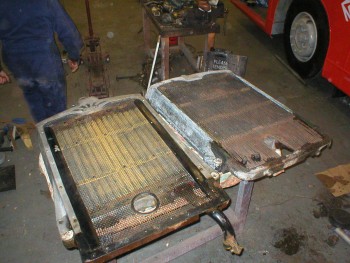 |
|
Flashback to last November
when the two radiators were laid side by side.
|
|
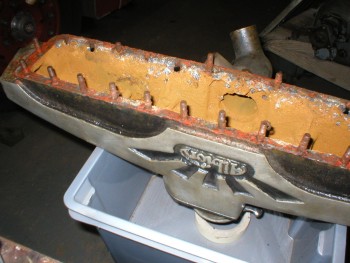 |
|
The
stripdown revealed that the flange of the 'sunrays' top tank
which came off 1877 is quite badly corroded.
|
|
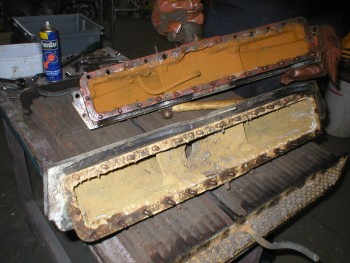 |
|
But the top
tank (nearer the camera) from the older radiator is in good
condition.
|
|
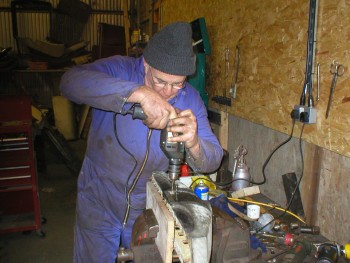 |
|
On his last
day with us David Griffiths is seen drilling out the broken
screws which retained the rectangular badge.
|
|
 |
|
Several weeks later the rebuilding of the radiator is nearly
completed.
|
|
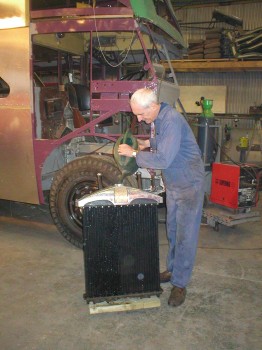 |
|
With the top tank and the
bottom tank bolted to the core Paul fills the radiator to
see if it is watertight.
|
|
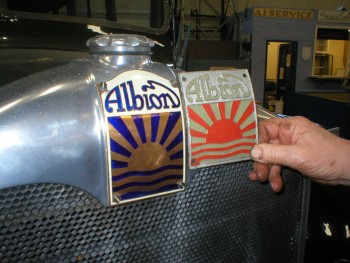 |
|
John holds
the brass badge for 1877 alongside Dave Hurley's PK114
Victor at Lathalmond. Dave's badge is enamelled. The badge
John is holding came off a Glasgow Venturer parked in the
disposal line in 1966, retrieved before the scrap man came.
The non-original colours are a later addition.
|
|
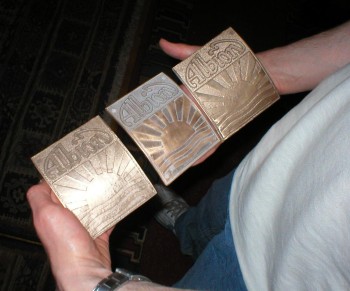 |
|
The same
badge (in the middle) has been stripped of paint and two
copies made. There is no trace of enamel on the original
badge.
|
|
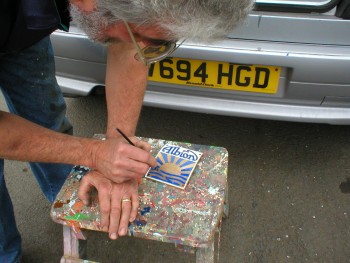 |
|
Lathalmond
painter Peter Mitchell paints one of the copy badges. Dave
Hurley contends that brass badges affixed to postwar
radiators were painted, not enamelled. The fact there was no
trace of enamel on this badge when it was removed in 1966
appears to bear this out.
|
|
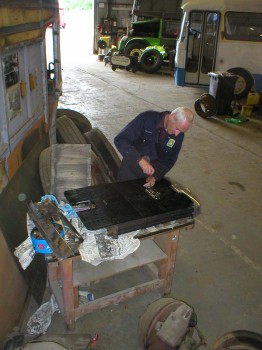 |
|
Paul
attaches the 'Albion Venturer' badge on the grille. This is
another copy of an original badge retrieved by Paul back in
1966.
|
|
 |
|
The finished
radiator fitted to the bus. Only the side supports are from
the original radiator that came off 1877. The side supports
from the Glasgow radiator were of the early prewar pattern
and not suitable for 1877. |
|
|

